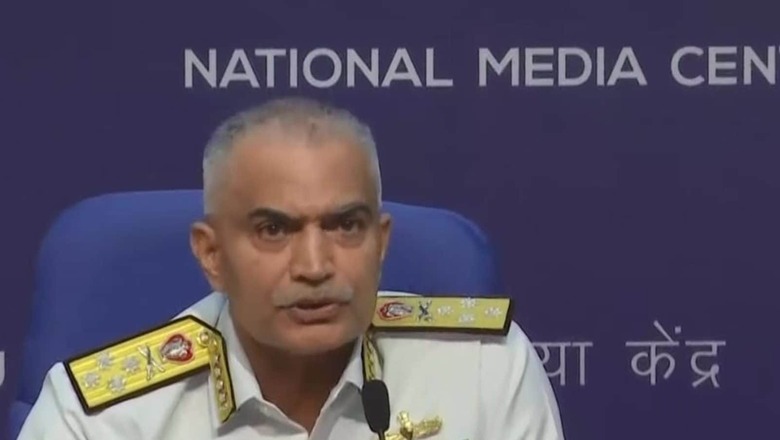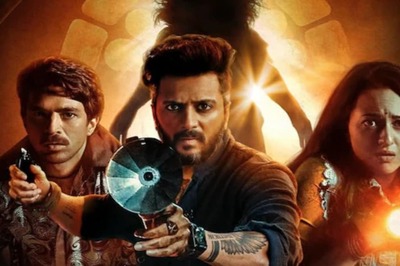
views
The Agnipath recruitment scheme for the armed forces that has been hailed as “transformational" by the three service chiefs has witnessed protests and even violence in parts of India in the aftermath of its announcement by the Centre. Speaking exclusively to CNN-News18, Chief of the Naval Staff (CNS) Admiral R Hari Kumar underscored the lengthy process and extensive deliberations that took place before the implementation of the scheme, the many benefits it brings for the youth and the armed forces, and how the Agniveers can look forward to a secure future. Edited excerpts:
Agnipath has the endorsement of all three service chiefs. It has been in the works since long, is what we are being told. Could you give us an idea of the philosophy?
The idea of Agnipath originated from the recommendations of the Kargil Committee Report where they had suggested reducing the age profile of the armed forces. In the study which was done, the profile was around 32 years, which was considered too high for a fighting force. So, therefore, various options were looked at, various methods were examined and the Agnipath scheme came as an outcome of that. When we implement the scheme, in a time of around 12 years or so we will be able to bring down the age profile to around 25, less than 24 definitely, which is a substantial improvement and operational necessity that will give a fitter, more agile, technically savvy and modern force.
You are pitching this as some kind of game changer but the youth that are protesting have some questions. I am raising them and asking about their concerns and doubts. What about the job security of the youth and what will happen when they stay Agniveer for four years? What next?
See, unlike now wherein they are joining the service and then leaving it after working for 15-20 years for going abroad, they will now come by 17-17.5, serve till 22, and then go abroad. They have the option to choose between continuing the service or doing something they like or going abroad. This option is currently not there. Currently, if you are enrolled as a sailor or soldier, they have to serve for 15-20 years and then go abroad, this is an advantage. Secondly, the number of Agniveers enrolled will increase. Now, we enrol 4,000-5,000 people in the Navy each year, but as the scheme goes up, we will have to retain 25%, so we will recruit four times the number. We will recruit 18,000-20,000 people each year.
You mean to say job opportunities will increase?
Yes, job opportunities for a shorter time period will increase. So, opportunities for every youth to join the armed forces, which does not happen now, will happen.
Another question the youth is constantly asking is that two years of their life has been wasted by the coronavirus pandemic and now the age limit of one-time basis to happen in 2022 has been increased. Their concern is will the entire process happen again? How will the recruitment happen?
Since it is a new scheme, a lot of people will participate. We want it to happen at ‘all-class, all-India’ basis though the Navy already is…Our other agenda is that in due course every village should have one Agniveer. What will it do for the armed forces? It will develop a connection between the Aam Nagrik and the armed forces. This is also the larger aim of the scheme.
You are talking about the importance of Agniveers and you want that larger connection with every village of India, but the Navy for example needs specialists jobs, needs some kind of training and sophistication as well. In a period of six months and four years, is that enough? What we know is that it takes about six to seven years for you to be fully equipped and trained in the armed forces.
You are not aware of the training happening today. Today, a person who joins has a training period of 20 weeks as the basic establishment with 2-4 weeks on the ship. Thereafter, he does 4-5 months of professional qualification course and thereafter he is sent to ship, submarine, aircraft or operational unit. Here he learns the job, additional skills and continues. His next deeper knowledge or specialisation happens after 6 years, not before that. Today, what is happening is that we have reduced the 20 weeks training to 16 weeks, reduced the training by 4 weeks…The training we found redundant or not needed anymore and improved training processes to ensure the same kind of output is there. Then he does a two to four-week training on shift. Thereafter, he does professional training as an electrician, mechanic and so on. Thereafter he is deployed just like the guy working now.
Both paramilitary and police, or other civil service utilities like NDRF or fire brigade will benefit from the skill set?
I think the spectrum is wide and not restricted to CRPF or NDRF alone. I can tell you from the Navy side. They have shipping and all the shipping-related works with them. We have people who can do and will be qualified for tech, radio operator duties, work as technicians, function as mechanicians, electricians, logisticians, aviation, aircraft handlers, aircraft repair technicians. There is an entire ecosystem wherein they can just go and plug in.
The young people who are protesting have another question. Why couldn’t this scheme start with a pilot project? Because this will bring about radical changes. They are raising questions about the risk analysis. Shouldn’t you have communicated with the youth in a better fashion?
We didn’t introduce this scheme in a haste. This was in talks for two years. At that time. I was the chief of integrated staff; that post is also called VCDS. I had worked with Gen Rawat as well, and this scheme was discussed then too. The action-taken report of the Kargil Committee also had a mention of this, in one of its points, which is reducing its age profile. Since then we have been discussing this scheme. All the stakeholders, which included the service headquarters, finance ministry, ministry of skill development, have been kept in the loop. The model of this scheme has evolved after recommendations of the field units as well. Back and forth took place for two years regarding the scheme. All the stakeholders have been taken on board, and discussions have taken place… We discussed the percentage distribution as well, and pondered on what its distribution should be, should be it 60-40, 35-65, 70-30, and further should it be 3 years, and a second selection at 2 years or 4, 5, 6, or 7 years. There is a plus and minus for everything. Finally, we have arrived at an optimum number of years, so the Agniveer and the society will get a benefit. There will be more number of Agniveers for the society who will disseminate their experience in the society. The percentage of it has also been worked upon. All this has been discussed and deliberated in great depth, so we have arrived at this scheme.
The critics of the Agnipath scheme believe that there is an ethos, which is ‘naam, namak aur nishan’ (honour, loyalty and identity). There is an element of sacrifice which is a part of being in the Army. Now with the four-year time bracket, the spirit of sacrifice may be impacted while they will be thinking about what will happen after that time.
See, the armed forces work on only one principle of ‘naam, namak aur nishan’ and ‘service before self’. That is the basic ethos of how we function. These are the only services that are organised to deliver violence under unlimited liability. That means when a person signs up for the armed forces, they are willing to sacrifice themselves. This is the type of ethos that is there. The armed forces require people who are willing to serve in the interest of the nation and defend the country. And that is our charter.
That charter itself, which is of the nation before self, will be diluted because of this…
How will it be diluted? When you join, you are willing to sacrifice for the nation; that is the basic ethos. This is not a programme for conscription, this is a programme for volunteers, for people who are willing to do the desh seva (serving the country) for four years. If not then why should you enrol into this scheme? This is an opportunity for true patriots, for the youth who wants to contribute to the country, in larger numbers. Previously, as I said, the numbers were very less. Now we are looking at a larger number of youth joining the forces.
Your critics are saying that this is the beginning of a militarised society, and that the people who will be coming out will start changing the society.
Once the Agniveer enters the society, he is not a militarised man but someone who is experienced in the military and skilled in various other things. He is certified for various things, he would have received educational training for which he will be getting credits. He is self-confident, his personality gets developed. Now he is a guy who is head and shoulders ahead of his colleagues who have just graduated and are working a job. Why is there a doubt that he won’t be getting a job? He will be 100 per cent getting a job and he will be only 22-23.
The average age will come down but the good soldiers won’t be there.
Why won’t they be there? I just explained that training happens for a recruit in the first year. The next major training happens only after 5-6 years. So as far as an Agniveer is concerned, he is already trained to do a similar job, and those who are retained in service will specialise, whether it is in equipment repair or other specialised fields. So there is no change that is happening in the 3 years.
I want you to address the youth on the roads, because they are scared and their fear is visible on the roads. Trains have been burnt, protests are happening, roads have been blocked, and a lot of inconvenience is being caused. What would you say?
My advice to the youth is to remain peaceful, protests and violence are useless. This scheme is one of the best, it will help the youth to take part in nation-building, to skill themselves. There are a lot of benefits including developing his skills, his personality to handle himself and various other things like he will be physically fit and more importantly, he has an option to leave the service if he thinks he is not fit for it and can look for another job. They should look at the scheme in a mature manner and peacefully go into the details of the scheme…Earlier only one person could join, now 4 of them can even for shorter durations. But the advantages that they will gain will be substantial. And after 4 years when they come out and compare themselves to others who would be in universities, they would realise they are head and shoulders better than them.
Read all the Latest News , Breaking News , watch Top Videos and Live TV here.


















Comments
0 comment